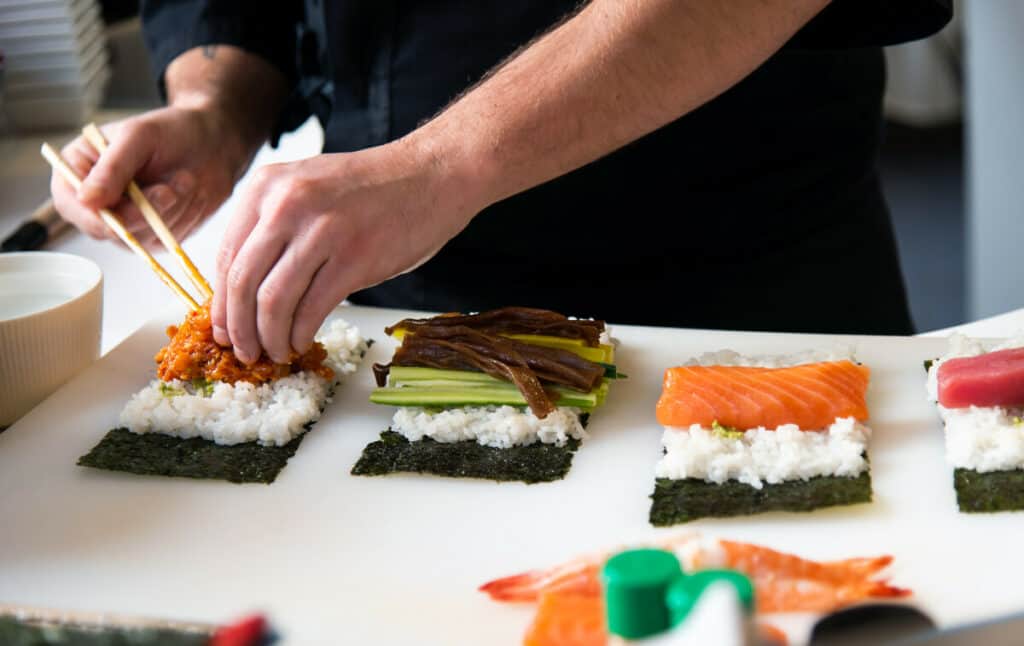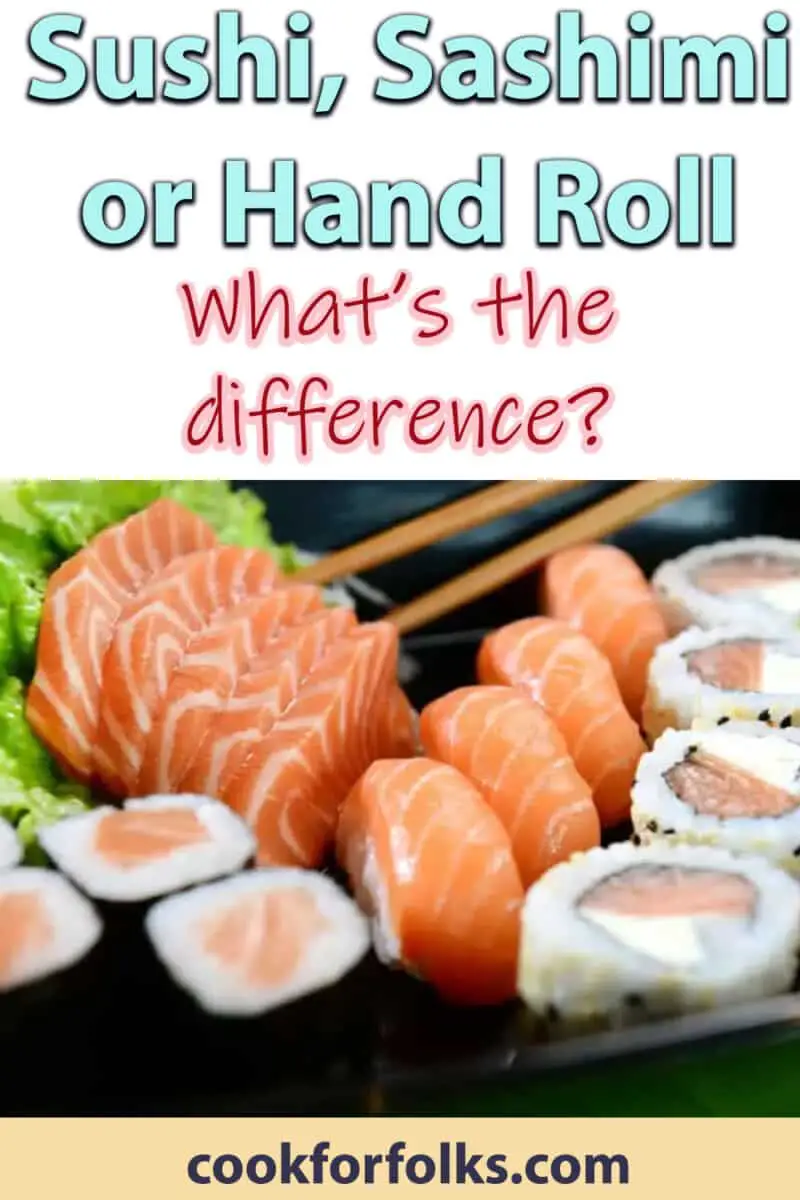This post contains affiliate links.
It’s common for people to look at raw fish and rice and call all of it “sushi.” However, there are various styles of eating fish, whether it’s raw, with rice, not with rice, with your hands, and whatever the differences might be. They all have unique names, preparations, and ingredients that set them apart from each other.
Sushi consists of small cooked rice balls either topped with raw fish or filled with fish, vegetables, or egg rolled in seaweed. Sashimi is thin slices of raw fish and no rice. A hand roll is a cone-shaped seaweed filled with varying ingredients like fish and vegetables and is eaten by hand.
Keep reading to understand more about what makes these foods different so you can order the right food when next you go to a restaurant that sells these types of foods.
What are the Differences Between Sushi, Sashimi, and Hand Rolls?
The main reason that these are different has to do with the ingredients and the preparation. Sushi means that there’s vinegar rice either underneath a slice of raw fish, or a sushi roll. Nigiri sushi is when the rice is almost in a ball formation, and the fish lays on top from end to end, covering the rice.
Sashimi is very simple. It is just thin-sliced fish that’s also raw. The easiest way to differentiate sashimi from the rest is that you’ll notice there’s only one ingredient; meat.
A handroll looks quite different from the other two. It is known as the taco version of sushi rolls. The seaweed looks like a cone and at the open end, you can see the ingredients spilling out. Ingredients inside a handroll are similar to a sushi roll, but you eat it with your hands rather than using any utensils.
What’s the Difference Between a Sushi Roll and Hand Roll?
Even though these both contain the same ingredients most of the time, what makes them different is the shape, the way you eat them, and the availability.
- Sushi rolls are rolled into a tubular form by a bamboo mat, then covered in seaweed. Hand rolls are rolled into a cone shape.
- Sushi rolls are consumed by eating with chopsticks and are cut up into 6-8 pieces. Hand rolls are eaten with your hands and you just bite into them.
- Sushi rolls are found at every sushi restaurant and even other places to eat that aren’t strictly sushi or Japanese. It’s harder to come across hand rolls and find restaurants that sell them. (Source
 )
)
When talking about sushi, this will be referencing sushi rolls and nigiri, because these are the main forms of sushi. However, these are some types of sushi and what each one consists of. These titles for sushi are in Japanese, which is common at almost every Japanese restaurant outside of Japan, so it’s convenient to understand what they mean.
| Type of Sushi | Definition |
| Nigiri | Long and thin structures of rice topped with slices of raw fish. |
| Maki | Sushi rolls that are cut into bite-size pieces wrapped in seaweed on the outside of the rice. |
| Uramaki | This is like maki, but the rice is on the outside of the seaweed instead of the inside. |
| Temaki | A handroll, which is basically a sushi roll except rolled into a cone shape. |
| Chirasashi | It means “scattered.” A bowl of rice topped with raw fish slices and various garnishes. Sometimes fruit and vegetables are in the bowl as well. |
 )
)Ingredients In Sushi
Fish
- When it comes to nigiri sushi, it’s usually topped with raw fish. The most common types of fish used for nigiri are tuna, salmon, yellowtail, or halibut. Not all nigiri has to be raw though. There are fish in this style of sushi that they cook before serving, like eel and shrimp. (Source)
- Sushi rolls include raw, cooked, and tempura fish. These rolls have fish usually inside the roll, covered in rice and seaweed. There are also rolls where the fish are laid on top of it as well. A lot of the time, this fish is raw. If it’s not raw, it’s either a cooked fish, like eel or smoked salmon, or it’s tempura. Tempura rolls are where fish is dipped in a batter and deep-fried to create a crunchy taste. The sushi roll is held inside the batter.

Rice
- For rice, sushi rolls, and nigiri, use what’s called “sushi rice.” This is made by cooking Japanese short-grain rice and seasoning it with rice vinegar, sugar, salt, and sometimes kelp. It is different from making regular white rice. The sushi rice is stickier, which makes it moldable for rolls/nigiri, and it has a sweet flavor. (Source)
Seaweed
- As for nigiri, there is sometimes seaweed involved. it is either served as just the rice and fish, or there is a thin sheet of seaweed to bind the fish and rice together. It simply wraps around, similar to tying a small rope to keep them aligned. It’s more common to see nigiri without seaweed.
- For sushi rolls, there is always going to be seaweed either wrapped around the fish and inside ingredients or around the outside of the rice holding it all together. The type of seaweed used for this is called “nori,” which is a red seaweed that comes pressed into thin dry sheets. They look dark green or black. (Source)
Toppings
- Sushi rolls can be topped with a wide variety of different items. Some popular ones are sesame seeds, fish roes (fish eggs), crab, egg, tempura flakes, cucumber, nuts, more fish, etc. Any of these, and more endless options, can be put on top of a roll and usually, specialty rolls have some sort of topping or garnish.
- It is also common for rolls to be drizzled in a sauce. For example, really popular ones are eel sauce, sriracha, spicy mayo, dynamite sauce, and more.
- Nigiri does not typically have as many toppings as sushi rolls do. But it is often served with soy sauce brushed on top, salt, or eel sauce. What’s more likely to be on top of nigiri is some sort of garnish-like green onion or nuts. Nigiri and sushi rolls are both always served with soy sauce to dip in, wasabi, and pickled ginger leaves.
Vegetables
- Nigiri doesn’t usually come with any vegetables. It can be served on a plate that’s garnished with vegetables, but never really includes this with the fish.
- There are many options when it comes to vegetables inside sushi rolls. The most common vegetables inside a roll are cucumber, avocado, asparagus, and more. In fact, a popular type of roll to get is called a “veggie roll.” This only consists of vegetables inside. For example, people who don’t eat meat might get a roll that has only avocado and cucumber inside or a roll with sweet potato.
Ingredients in Sashimi

Fish
- Sashimi means “pierced body” or “pierced meat” and is only made with thin and delicately cut strips of raw meat.
- Usually, restaurants serve sashimi made from salmon, tuna, halibut, squid, yellowtail, squid, octopus, and Japanese mackerel. There is sashimi that contains other meats like chicken or horse, but it’s hard to find that served in the United States.
Toppings
- Sashimi is served generally without toppings but with vegetables, ginger, and wasabi on the plate.
- A popular food to put next to the delicately sliced sashimi is white daikon radish and shiso leaves. The white daikon radish is usually in thin strips and the shiso leaves are an herb in the same botanical family as mint. Both are meant to be eaten with the dish, but can also be pushed aside.
- Sashimi is served generally without toppings but with vegetables, ginger, and wasabi on the plate.
- A popular food to put next to the delicately sliced sashimi is white daikon radish and shiso leaves. The white daikon radish is usually in thin strips and the shiso leaves are an herb in the same botanical family as mint. Both are meant to be eaten with the dish, but can also be pushed aside.
Ingredients in Handrolls

Fish
- For handrolls, they can contain similar fish to sushi. Many hand rolls are the same ingredients as sushi rolls, they are just prepared and eaten differently, so almost any fish used in sushi can be put into a handroll.
Rice
- Since handrolls are the same as sushi rolls, just in different forms, they also use sushi rice. Rice is not needed for a handroll though, in fact, there are a lot of handrolls that don’t include rice. When they don’t have this ingredient inside, it’s because the fish or other ingredients are the main content.
Seaweed
- Like sushi rolls, handrolls use nori.
Toppings
- Since handrolls are eaten from one end to the other and covered in seaweed, they aren’t served with toppings as frequently. Usually, what’s included in the handroll, or sushi roll that’s being converted into one, fits inside the seaweed so it can be easily eaten.
- Depending on the hand roll, there can still be toppings. These are served with wasabi, ginger, and soy sauce as well.
Vegetables
- There is a wide range of vegetables that could go inside a hand roll. Just like sushi rolls, cucumbers, avocado, asparagus, or other types are common and go well with fish. It is also possible to get veggie hand rolls that only include vegetables, which are a great vegetarian option.
Nutritional Differences

Sushi and hand rolls both have higher carbohydrate content and fiber than sashimi. This is because sushi and hand rolls use rice, seaweed, and vegetables versus sashimi, which is made up of raw meat. Sushi has more calories than sashimi because of the rice, which is good or bad depending on how many calories you are trying to intake for that meal. (Source )
)
One piece of sushi is about 37 calories, and a full serving (125 grams) is roughly 179 calories. Sashimi is about 25 to 40 calories per ounce, so a lot fewer calories than sushi.
Sashimi includes a lot of protein and heart-healthy fats like omega-3 fatty acids, which contain a lot of health benefits. Overall, they both contain fish, which is often raw, so they have similar nutritional benefits. The main difference as far as health is that sushi contains more ingredients that have their own elements, like rice and seaweed. (Source )
)
| Ingredients | Benefits |
| Omega-3 fatty acids | Omega-3 fatty acids can prevent heart attacks, strokes, and cardiovascular diseases. Regulates inflammation and promotes heart health. Good for your brain health. |
| Protein | Enhances memory and concentration. Helps tissue repair, wound healing, and muscle growth. Eating protein-rich food helps reduce food cravings and helps with appetite control. Good for one’s metabolism. |
| Iodine (seaweed wrappers) | Iodine can regulate the endocrine and hormones in your body, which helps balance them. |
| Antioxidants | Promotes healthy skin. |
| Vitamin D | Prevents and treats depression. |
 )
)What’s the Price Difference?
Typically, sashimi is the most expensive out of the three. That’s because it’s made out of very high-quality and fresh fish. The way that the fish is caught affects how expensive it is, which is why sashimi almost always costs more than sushi or handrolls. The way that fish used for sashimi are caught is more labor-intensive than how the fish used for sushi is caught. Also, it takes a lot of skill to prepare sashimi correctly, so chefs that can prepare it are paid more than chefs that can’t.

Sashimi also has to be stored in a certain way to be safe to eat, as bacteria grows quite quickly in fish. In fact, most types of sushi cost more than meals at other restaurants because of the preparation and storage required.
Hand rolls typically fall in the middle of sushi and sashimi when it comes to price, as few ingredients are used and both the seaweed and rice used are typically cheap. Fish is the most expensive ingredient found in hand rolls.
Overall, there are many differences between hand rolls, sushi, and sashimi. When you next go to a sushi restaurant, you will easily be able to determine which one you want to eat. However, all of these foods may not be found at the same restaurant, so if you have one of these foods in mind when you go out to eat, call the restaurant you are going to beforehand and make sure they have it.

